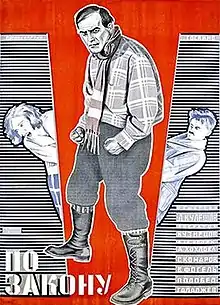By the Law
By the Law (Russian: По закону, romanized: Po Zakonu) is a 83-minute silent drama film released on 3 December 1926. The film was directed by Lev Kuleshov and produced by the Soviet production company Goskino.[1][2]
| By the Law | |
|---|---|
 | |
| Directed by | Lev Kuleshov |
| Screenplay by | Viktor Shklovsky Lev Kuleshov |
| Based on | "The Unexpected" (1905) and "Just Meat" (1906) by Jack London |
| Starring | Aleksandra Khokhlova Sergey Komarov Vladimir Fogel |
| Cinematography | Konstantin Kuznetsov |
Production company | |
Release date |
|
| Country | Soviet Union |
| Language | Silent |
The narrative is based on the Jack London short story "The Unexpected" (1905) and "Just Meat" (1906).[3] The plot concerns a group of gold prospectors in the Yukon region of Canada during the Klondike Gold Rush.[4][5]
Plot
A group of five gold miners originally from Western Europe find a large deposit in the Yukon during the Klondike Gold Rush. The group is composed of Michael (Irish), Hans Nelson (Swede and leader of the expedition) and his wife Edith (English), Dutchy (Dutch) and Harky.[6]
Michael, the one who handles all the manual work and found gold for the group, gets frustrated as the other members still treat him as a subaltern. One day, Michael enters the cabin with a rifle for hunting or protection and, in a moment of madness, shoots dead two of his comrades, Dutchy and Harky. The remaining two, Hans Nelson and his wife Edith, disarm him. Hans Nelson wants to kill Michael, but his wife Edith opposes the idea, arguing "You can't kill him - only the law can punish him." They face the dilemma of whether to administer justice themselves or risk waiting for the thaw and then trying to return to civilization to render the offender to the public court.[6]
Cast
- Alexandra Khokhlova as Edith Nelson
- Szergei Komarov as Hans Nelson
- Vladimir Fogel as Michael Dennin
- Pyotr Galadzhev as Harkey
- Porfiri Podobed
- Fred Forell as Jack
Production
After trying his filmmaking skills in different genres, Lev Kuleshov decided to make a film using minimal resources and a strictly limited number of actors ("chamber film").[3] After reading the Jack London short story "The Unexpected" and "The Meat", he wrote a script with Viktor Shklovsky based on the narrative.
Kuleshov and co-screenwriter Shklovsky initially thought that the studio would be interested in a low-budget feature with three actors in one setting but the script was rejected and only after an article appeared in support of the picture in the magazine "Soviet Screen" was the film greenlit.[2]
For the role of Edith Nelson Lev Kuleshov cast his wife, actress Aleksandra Khokhlova.[2]
The filming was done in the Moscow Oblast, not far from the Tsaritsynsky ponds. The shore of the Moscow River and two trees near the water created the illusion of the wild northern Yukon. On the riverside, a house of prospectors was placed in which the interior scenes were shot.[2]
Shooting conditions were extremely difficult; cold winter scenes were shot in April and inundation occurred. The decoration of the house was flooded, the crew was knee-deep in water and actors often faced electric shocks because of the damaged insulation of the wires.[2]
Reception
The film was received positively abroad in non English speaking countries; in Anglo-regions it was released only in 1939.[5] In Paris, the film was well-received by the critique.[6]
Interesting facts
- Original script of the picture was called "Three."
- For the shooting of the film high and warm "American" boots were sewn for Alexandra Khokhlova which the actress enjoyed so much that after she finished working on the film she ended up keeping them for herself.
- In the course of working on the film various alternative endings were examined, but eventually it was decided to leave Dennin alive.
References
- "По закону". Encyclopedia of Native Cinema. Retrieved 30 January 2017.
- "По закону". VokrugTV.
- Bryant, Nathaniel Heggins (2 January 2019). "Klondike on the Moskva: Lev Kuleshov, the Jack London short story, and the chamber film". Studies in Russian and Soviet Cinema. 13 (1): 40–58. doi:10.1080/17503132.2019.1548073. ISSN 1750-3132.
- Klinowski, Jacek; Garbicz, Adam (2012). Feature Cinema in the 20th Century: Volume One: 1913-1950: A Comprehensive Guide. United Kingdom: Planet RGB Limited. ISBN 978-1-62407564-3.
- Jay Leyda (1960). Kino: A History of the Russian and Soviet Film. George Allen & Unwin. pp. 212–213.
- "By the Law 1926". www.silentsaregolden.com. Retrieved 16 December 2020.
